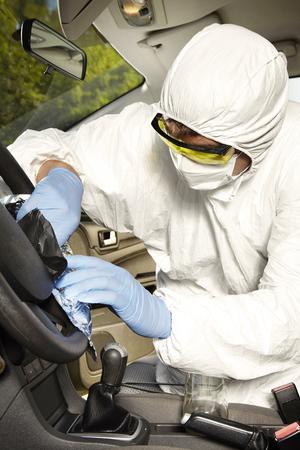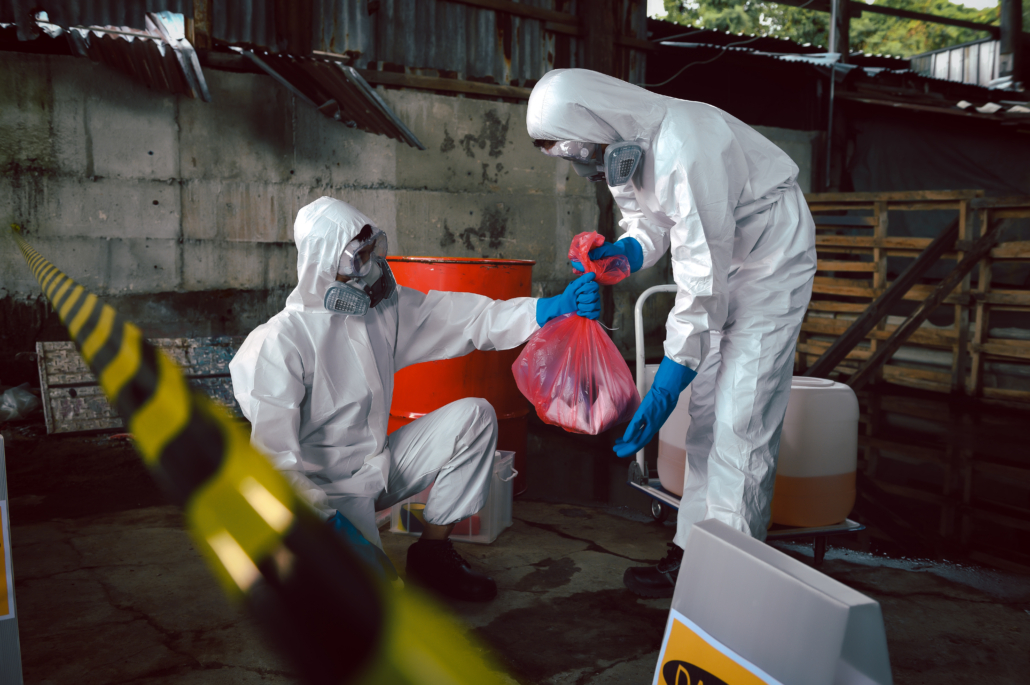Flood Damage Restoration: Quick and Effective Healing for Your Home
Flood Damage Restoration: Quick and Effective Healing for Your Home
Blog Article
Professional Biohazard Cleaning and Purification for Blood, Bodily Fluids, and Hazardous Products
The potential wellness risks linked with exposure to biohazards highlight the crucial need for thorough handling and extensive cleaning. As we navigate the complex landscape of biohazard cleanup, comprehending the subtleties of policies, conformity, and the specialized tools at play becomes imperative in making sure a thorough and safe purification process.
Health And Wellness Threats of Biohazard Exposure
Exposure to biohazards positions considerable health dangers that can result in serious consequences for individuals and communities alike. Biohazards encompass a variety of organic substances, including blood, physical liquids, mold and mildew, bacteria, viruses, and other potentially transmittable products. When people come right into contact with these biohazards, whether through mishaps, incorrect handling, or ecological direct exposure, they encounter the threat of having major health problems or conditions.
One of the main health and wellness dangers linked with biohazard direct exposure is the transmission of transmittable conditions. Bloodborne virus such as HIV, liver disease B and C, and numerous microorganisms can be existing in biohazardous materials, posing a direct risk to human health and wellness. Inhaling airborne biohazards like mold spores or entering call with infected surface areas can additionally bring about respiratory system concerns, allergies, and other adverse health results.
In addition, biohazard direct exposure can have long-lasting wellness effects, with some conditions materializing years after the initial contact (Blood Cleanup). Therefore, it is essential to prioritize proper biohazard cleansing and decontamination to reduce these health threats and make sure the security of neighborhoods and individuals

Specialized Training for Biohazard Cleaning
When it concerns taking care of biohazard clean-up successfully and safely, specialized training plays a basic duty in ensuring correct purification procedures are complied with. Biohazard cleaning requires certain expertise and skills to efficiently minimize risks related to bloodborne virus, physical fluids, and dangerous products. Specialists trained in biohazard clean-up undertake rigorous guideline on how to securely take care of, remove, and get rid of biohazardous products to stop contamination and direct exposure.
Specialized training for biohazard cleaning covers a series of vital subjects, consisting of correct personal safety devices (PPE) usage, bloodborne microorganism awareness, purification techniques, and dangerous waste disposal methods. People learnt biohazard cleanup are geared up with the essential knowledge to analyze contamination levels, determine possible risks, and carry out suitable clean-up procedures in compliance with regulative criteria.
Continual training and education and learning are extremely important in the field of biohazard clean-up to remain upgraded on the most up to date purification modern technologies, safety procedures, and regulations. By investing in specialized training, biohazard clean-up professionals can effectively respond to emergency situation cleanup situations and guard both public health and wellness and the setting.
Importance of Proper Decontamination Methods
Using appropriate purification methods is important in biohazard clean-up to efficiently minimize and remove dangerous products health dangers. Effective decontamination not only ensures the elimination of visible traces of blood, bodily liquids, and other biohazards however likewise targets unnoticeable microorganisms that might pose serious health and wellness hazards if not effectively gotten rid of. By following strict purification methods, educated specialists can dramatically minimize the threat of direct exposure to hazardous bacteria, viruses, and microorganisms that can cause infections or diseases.
Appropriate decontamination methods include using specialized devices and anti-bacterials that are specifically made to neutralize biohazards properly. Detailed cleaning and sanitation of contaminated locations are necessary to prevent the spread of virus and ensure a risk-free atmosphere for owners. Additionally, the appropriate disposal of biohazardous waste complying with purification procedures is essential in avoiding contamination of other surface areas or people.

Tools and Devices for Safe Clean-up
The appropriate equipment and tools play a crucial role in making certain the efficient and safe cleanup of have a peek here biohazardous materials. When dealing with blood, physical fluids, or dangerous materials, biohazard cleansing experts rely upon Bonuses specialized gear to decrease direct exposure risks and thoroughly decontaminate the afflicted location. Personal safety tools (PPE) such as handwear covers, coveralls, goggles, and masks are important to safeguard versus straight contact with possibly transmittable materials. Additionally, biohazard cleansing kits consisting of anti-bacterials, absorbent products, and biohazard bags are used to securely include and get rid of of polluted items. Blood Cleanup.
Advanced cleaning devices like hospital-grade disinfectants, HEPA-filtered vacuums, and misting machines are utilized to disinfect surface areas and remove biohazards successfully. Specialized tools such as sharps containers and biohazard waste disposal bins are used to securely manage sharp items and biohazardous waste products. By making use of the right equipment and tools, biohazard cleaning specialists can guarantee a thorough cleanup process that prioritizes security and lessens health dangers for both workers and occupants of the afflicted room.
Regulations and Compliance in Biohazard Cleansing
Correct adherence to guidelines and conformity standards is vital in biohazard cleansing to make certain the safety of both personnel and the setting. Federal government firms such as OSHA (Occupational Safety And Security and Health Administration) and the EPA (Epa) have developed certain standards for biohazard cleaning treatments to decrease wellness threats and ecological contamination. These guidelines cover a series of elements including the handling, transportation, and disposal of biohazardous products, along with the needed training and safety tools needed for workers included in the cleanup process.
Biohazard cleansing business need to stay up-to-date with these laws to guarantee that their procedures fulfill the needed safety standards. Failing to follow these laws can cause severe repercussions, consisting of fines, lawful activity, and endangering the health of people and the setting. By complying with rigorous laws and conformity steps, biohazard cleansing companies can efficiently reduce threats and make sure a safe and extensive cleanup procedure for all parties involved.
Final Thought
To conclude, biohazard cleaning and decontamination call for specialized training, appropriate methods, and adherence to regulations. Direct exposure to blood, bodily liquids, and hazardous products postures significant health threats, making it vital to utilize the appropriate equipment and how to clean up blood spill tools for risk-free clean-up. By adhering to rigorous methods and guidelines, professionals can effectively reduce the risks linked with biohazard direct exposure and make certain the safety and security of both themselves and others.
As we browse the intricate landscape of biohazard clean-up, understanding the nuances of regulations, compliance, and the specific devices at play ends up being critical in guaranteeing a complete and secure purification process. (Blood Cleanup)
When it comes to managing biohazard cleanup efficiently and securely, specialized training plays a fundamental function in making certain correct decontamination treatments are adhered to.Using proper decontamination techniques is critical in biohazard cleaning to efficiently minimize and eliminate hazardous products health risks. Additionally, biohazard cleansing kits including disinfectants, absorbent products, and biohazard bags are made use of to safely contain and get rid of of polluted products.
Government firms such as OSHA (Occupational Safety And Security and Wellness Administration) and the EPA (Environmental Security Firm) have developed particular standards for biohazard cleaning treatments to lessen health risks and environmental contamination.
Report this page